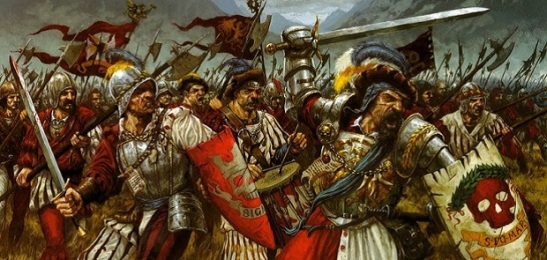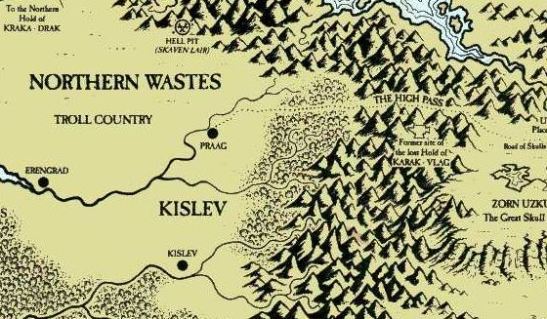Lorehammer: the Great War Against Chaos
The Great War Against Chaos
These events happened roughly 200 years before Warhammer’s present day. However the events of this war still loom large over many of the factions, and even the geography of the land.
It Begins
The winds of chaos surged and roiled, blowing fierce and foul upon the world. Those who know things knew this was an evil portent. The chaos gods had temporarily ceased their bickering and settled on a champion. The tribes of Norsca had united, and looked south for plunder and killing.

The Tsar of Kislev began arming his forces, and sent emissaries into the lands of the Empire and the Dwarfs seeking aid.
These voices largely fell on deaf ears. The dwarfs faced problems of their own, with their holds besieged by orcs and chaos beasts from the mountains. The Empire was divided, with no clear claimant to the throne, and a group of Elector Counts more focused in internal intrigue than external threat.
Magnus the Pious
One exception was Magnus, later called the Pious for his devotion to the faith of Sigmar. He recognised the threat of chaos was different this time and travelled from province to province appealing to nobles and commoners alike.
Slowly at first the Elector Counts came round to Magnus’ way of thinking. Whether they made this decision themselves or were swayed by popular opinion and the sight of commoners flocking to Magnus’ banners is not recorded.
In time, the army grew so large it split in two, with the first army marching north in haste. Word had come that the cities of Praag and Erengrad were threatened. The second army remained in the Empire under Magnus, gathering the last few men to fight.

Arrival of the High Elves
Magnus hadn’t trusted solely in the strength of men. He’d also sent emissaries to Ulthuan to request aid from the High Elves. At this time elves were little more than myth, having long departed the lands of the Old World. The emissaries arrived at the conclusion of the first stage of the Great War Against Chaos, which had seen daemons and Dark Elves ravage the lands of Ulthuan. The invaders had been beaten back, but only at a great cost in lives and land. The High Elves were neither willing nor capable of sending an army to aid Kislev.
Instead three High Elf mages returned with the emissaries, arriving as Magnus concluded his own preparations. Their principal contribution was to convince Magnus to make use of human wizards. Hedge Wizards, as they were known, were generally mistrusted and lived apart from others. The elf mage Teclis formed them into a group capable of aiding the men of the Empire.
Praag
Two armies now marched north from the Empire, but it was too late for Praag. After a protracted siege the city fell to the armies of chaos. Beasts, daemons, and warriors rampaged through the streets and the next morning the chaos arm marched to their next objective: Kislev. Not a single living soul remained in Praag. What horrors were visited upon that doomed populace none can tell, for there are no living witnesses.

The first army of the Empire reached the ruins of Praag. What they saw caused them to immediately turn and march on the trail of the chaos army, determined no other city should suffer the fate of Praag.
Erengrad
Geography was no friend to Erengrad. As the city furthest from Kiselv and closest to the Norscan tribe no army came near capable of providing relief. The full force of the Norscans arrived at their walls. Magnus marched his men towards Kislev, and the first army of the Empire had marched straight to Praag. Erengrad too fell to a night of looting by the Norscans. At this point the tribes turned back to their homes, content with their spoils so far. No second chaos army would approach Kislev. Part of Magnus’ army moved to aid Erengrad, and succeeded in ensuring there would be no second successful attack on the city.
Battle at the Gates of Kislev
Kislev was forewarned and somewhat forearmed. Not only men guarded its walls as the dwarfs of Karak Kadrin had thrown back the orc invaders and sent a relief force to guard the realms of men. However all they could do was keep the massive army of chaos undivided from breaching the walls. Defeating the army was a task beyond Kislev’s defenders.
Then Magnus arrived. His army wasted no time in assaulting the chaos army. Teclis, the other High Elf mages and their human apprentices assaulted the daemonic elements of the army with magic, to which they proved particularly vulnerable. Beasts and warriors clashed with men outside the walls even as the defenders were finally beaten back by the gors who took walls red with the blood of men and dwarfs.
Many great deeds were performed in the battle, but numbers will tell their own story. The chaos army was too large.
At this point the first Empire army appeared, standing on what today is still called the Hill of Heroes. Eager to avenge the dead of Praag, they smashed into the chaos army from a third direction as the defenders of Kislev surged back.

In the swell of melee Magnus met and slew the chaos leader. At this point the chaos army ceased to exist as a single functional force. The battle was over, but the killing continued.
The aftermath
The war left its indelible mark on the land and people, and this endures into Warhammer’s present, which we see in Warhammer: Total War. Bonds of friendship between men and dwarfs were strengthened as a result of the blood shed together at Kislev, and this loose alliance continues to ensure the survival of both groups.
Praag
If the walls of Praag could tell their tale, strong men would weep to hear it. The city was completely demolished and then built anew after the war. The mark of atrocity lingers. Distant screams are sometimes heard on the wind. Tortured faces form on windows and stones, only to disappear at a second glance. The city retains a grim air and is often referred to as the Cursed City of Praag.
Karak Vlag
The hold of Karak Vlag was completely encompassed by the winds of chaos at the start of the war, and nothing was heard from the keep during or after the war. When other dwarfs travelled north to find their kin, they found… nothing.

The entire hold and everything and everyone in it was simply gone. To this day none know the fate of Karak Vlag, and the subject that will make dwarfs go quiet.
The Colleges of Magic
The performance of human wizards at the Gates of Kislev convinced the new Emperor Magnus of their worth, but how could they be incorporated into the Empire with such a history of mistrust? The elf mage Teclis contrived a solution that suited all interested parties.
The Imperial College of Magic was founded to teach loyal subjects only, and to watch out for the taint of chaos. Students would choose to study one of the winds of magic only, and learn nothing of the higher magics. This appeased the other High Elves who were not keen on founding a force of magical rivals. Since this time the Colleges have become an indispensable part of the Empire.
In Warhammer’s present, the winds of magic blow strong once more…












Pingback: Using Regiments of Renown to preview new races | Scent of a Gamer
Pingback: 2016 in review | Scent of a Gamer